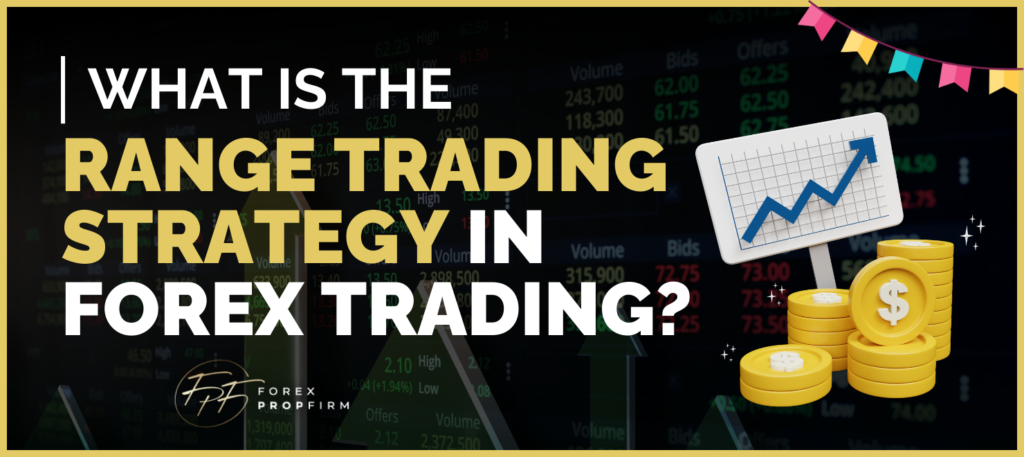
In the forex world, whether you’re investing with a forex broker or joining a Forex Prop Trading Firm to demonstrate your trading skills, the strategies you will use play a key role in your journey.
Range trading strategy is one of the most versatile and effective methods to gain profit. Best Forex Traders make sufficient profit in range-bound markets while traders with less knowledge and discipline lose all their gains in the range-bound times.
Let’s explore so you can make the best trading decisions, we will be discussing:
- The intricacies of range trading strategy in forex.
- What is the Range trading strategy?
- The difference between range-bound and trending markets.
- The variations of range trading.
What is Range Trading in Forex?
Range trading strategy is slightly different from other Trading Strategies. Best Forex Traders use this strategy in a specific market period when the price fluctuates within a certain technical zone.
The trading zone of a certain range is known as a “Trading range”. It has upper and lower levels showing price swings in the trading range. Traders buy at the lower bounds and sell at the upper bounds to maximize their profit.
Trending Market vs. Range-Bound Markets
Analyze the difference between the trending market and the range-bound market to use the range trading strategy effectively and become the best forex trader.
| Aspect | Trending Market | Range-Bound Market |
| Direction | Clear, upward, or downward | Sideways, lacking clear trend |
| Price Movement | Higher highs or lower lows | Oscillates within a range |
| Momentum | Strong, with sustained moves | Weaker, with choppy price action |
| Technical Indicators | Trend-following indicators effective | Range-bound indicators like RSI or Stochastic useful |
| Trading Strategy | Trend-following strategies such as moving averages | Range trading strategies such as buying at support, selling at resistance |
| Risk Management | Trend traders use trailing stops | Range traders set tight stops at range boundaries |
| Market Psychology | Bullish or bearish sentiment | Neutral or indecisive sentiment |
Strategies for Range Trading
Range trading strategies operate on three foundational assumptions:
- Markets move either up or down with a 50/50 probability.
- Opportunities are created with every Price action movement as traders interact within the range.
- Each trading session has high and low levels to identify trading zones of a specific range.
Here we have some variations of the Range Trading Strategy:
Classic Range Trading
In Classic range trading, traders identify a range using support and resistance levels. Traders buy at lower levels and sell on peaks to make a profit in that range.
Breakout Trading
Breakouts are of two types, bullish where peaks cross the upper level, and bearish where the trends across the lower level.
When the price trend crosses either the upper or lower level of the identified range, traders enter the positions in the direction of the breakout, anticipating profit from this significant price movement.
Fade the Range
This variation is the opposite of classic range trading. Traders buy at the lower end of the range and sell at the upper one to fade the range. Traders do this to revert the prices towards the mean position so they can make a profit from this reversal.
Range Expansion Strategy
Traders use this strategy when volatility increases and large price swings are observed. Breakouts occur due to which the range widens. Traders adjust to these market movements rather than focusing on support and resistance levels. They sell at high volatility and buy in low Volatile periods.
Range Contraction Strategy
The range contraction strategy is the opposite of the range expansion strategy. Traders use this strategy in low Volatile periods. Trading volume is low during such periods, and price swings within a very narrow range.
Comparison between Range Breakout Strategy & Range-Bound Strategy
| Aspect | Range Breakout Strategy | Range-Bound Strategy |
| Definition | To capitalize on price movements outside a defined trading range. | To buy at the lower end and sell at the upper end of a trading range. |
| Objective | To catch significant price movements as price breaks out of the range. | To profit from price reversals within the trading range. |
| Entry Point | Enters trades after the price breaks above or below the established range. | Enters trades at the upper or lower bounds of the trading range. |
| Stop Loss and Take Profit | Typically uses wider stop losses and targets larger price movements. | Utilizes tighter stop losses and targets smaller price movements within the range. |
| Risk Management | Requires careful risk management due to potential false breakouts. | Emphasizes managing risk by trading within a defined range. |
| Market Conditions | Best suited for markets experiencing consolidation before a potential trend reversal. | Best suited for stable, range-bound markets with clear upper and lower boundaries. |
| Strategy Complexity | It can be more complex due to the need to identify genuine breakouts from false signals. | It is relatively simpler as it involves trading within a known range. |
| Profit Potential | Offers higher profit potential when successful breakouts occur. | Offers lower but more consistent profit potential within the range. |
Conclusion
In the Forex market, 30% of the time we’ve observed the trading market, and 70% of the time it’s the range-bound market. It is inevitable to survive without loss in the range-bound time without opting for a range trading strategy. Best Forex Traders have a deep understanding of Range Trading strategy to avoid loss and capitalize on profit in this risky period.

